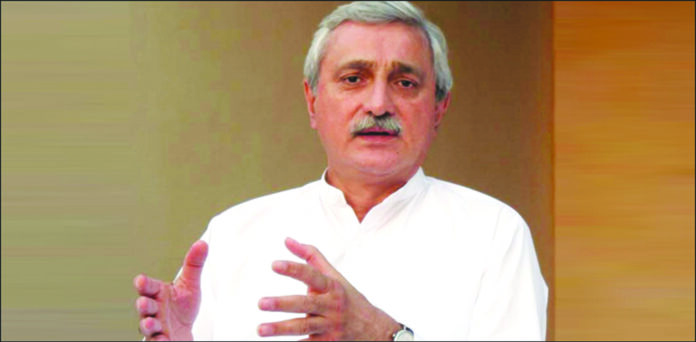AT PENPOINT
It was perhaps inevitable that the implosion of the Pakistan Tehreek Insaf should lead to the search for another King’s Party, but the fact that replacement King’s Party is being sought indicates that the establishment has not gotten out of politics as is being claimed.
The problem is that the PTI is not the only King’s Party on the political landscape, and to an extent, virtually all the parties have been at one time or another, King’s Parties. Indeed, critics of the current PDM coalition would argue that all of the parties currently in the ruling coalition are King’s Parties, and they would probably be right. However, politicians are malleable, and today’s King’s Party may be tomorrow’s trenchant opposition.
The PTI is a good example. How did a party which is alleged to have come to power with agency support, and which depended all along on the military for such mundane matters as getting votes, end up not merely criticizing the Army and accusing the top military leadership of trying to murder party chief Imran Khan, but actually staging an insurrection against it?
There is no simple answer, but the followers wanted Imran Khan to rule, and when the military apparently refused to back him, they turned against it. Imran actually managed to split loyalties, for he first played the patriotic card, and conflated patriotism with himself. The opponents realize the thin-ness of the story of an attempted insurrection with their talk of an attempted rebellion within the armed forces. It does seem that any rebellion which involved the trashing of military symbols was unlikely to win support from the cadres necessary for the success of a revolution.
Whatever happened on May 9, it did lead to the implosion of the PTI.
The party lost its chief spokesman, its secretary-general, and the presidents of the two provinces where it had formed governments. It lost members of the federal cabinet. In brief, it has lost most of the organizational structure it needs to carry it into the next election. However, it is well worth examining what will be the fate of those who have left the party.
It should be remembered that politicians have left. Some have announced a retirement from politics, while some have announced a break, which implies the possibility of a comeback. Also, these are electables. What is the point of being an electable if one is not going to contest an election?
However, there is a price. All of this brings the establishment back into politics. There will be many who will want this, because withdrawal will mean that they cannot play at politics as they once did.
There has to be a platform. One way would be for the King to form a new Party. There are some signs that this is happening. Indeed, there seems to be more than one hat in the ring. Jahangir Tareen is the apparent frontrunner, and he has been joined by Aleem Khan. Bothe had been known as Imran’s ATMs, until they fell out of favour with him. They have both got old links with the establishment, and are good candidates for favour. But is favour to be had?
Less seeking for favour, and more because of want of something to do, Murad Ras, a former Punjab minister, has announced the formation of a ‘democratic group’. So far, the aspirations seem limited to the Punjab Chief Ministership. None of the two seem likely to aspire to the Prime Ministersghip, and Ras only recently emerged as a chief ministerial possibility. However, he had little chance in the PTI, which seemed to have a plethora of candidates.
However, it might be instructive to see how King’s Parties have fared. The first, meant as a vehicle for Ayub Khan, the one whose ticket he got to contest the 1965 election, was the Pakistan Muslim League-Convention, or Convention League, as opposed to the PML-Council, or Council League. After Ayub’s fall, it remained around. It is interesting the number of Convention Leaguers who went into the PPP.
But did that make the PPP a King’s Party? It is true that a onetime Secretary-General of the Convention League headed the PPP, being none other than Zulfikar Ali Bhutto. One of his successors was Ch Zahoor Elahi, who began a career of supporting military rulers that has gone beyond his death, his son Shujat heading the PML(Q), another King’s Party.
However, though Bhutto initially maintained contacts with Ayun’s successor, Yahya Khan, there was a strong left wing in the party. Its leaders, like Mairaj Muhammad Khan, left the party, but the left-wing sensibiliity of the party remains, though now diluted to a sort of liberalism.
It took a military coup to remove the PPP, and Bhutto was hanged, but the replacement was the IJI, which went through a number of transformations until it became the PML(N). The PML(N) was a King’s Party in that it came to power with the approval of the establishment. However, if the PPP took over the left wing, the PML(N) took over the right wing.
After the 1999 military coup, the establishment drew out people from the PML(N), and the PPP, forming the PML(Q). When the PPP had to have Patriots drawn out, representing perhaps an even bigger desertion for that party since its ouster, they were given a home in the PML(Q).
However, the break-up of the PML(Q) saw many switch over to the PTI, while the rump was left to Ch Shujat. The PTI seemed ideal, for it was a new type of party, in that it became the political wing of the establishment.
Interest groups establish political parties. The most common type in the West are the social democratic parties, which are basically political wings of the trades unions. Pakistan has a number of sectarian parties, as well as ethnic parties, of which only the MQM has been successful. It is worth noting that all religious parties are sectarian, and though there may be some token representation of other sects, the bent of a particular party is clear.
Perhaps the PTI’s problem is that it does not find much space on the political spectrum. The PPP has taken the left, the PML(N) the right, so what is left, the centre? The centre is occupied by those parties who only enter power by forming a coalition with one of the other parties.
The problem was that the PTI acted for a group that was not its electorate. The establishment saw the PTI as the answer to its problems, a political party willing to act as its representative, much as the British Labour Party is the political arm of the Trades Union Congress, or the BJP of the RSS in India. However, the TUC and the RSS can both deliver a mass of votes on which the parties can base their electoral efforts. While the establishment could deliver some votes, that would have to be surreptitious, its main contributions were electables and ‘grey votes’.
The establishment’s much-touted withdrawal from politics, the munificent decision not to interfere, was prompted more by the realization that interference had not yielded the desired results of enhancing national power. Yet now it is being forced to interfere once again. The new King’s Parties being set up are not supposed to take power, only share in it, be coalition partners for the major parties. They are also meant to stop the PTI raising its head again. Most important, they are to make sure that May 9 is never repeated.
However, there is a price. All of this brings the establishment back into politics. There will be many who will want this, because withdrawal will mean that they cannot play at politics as they once did.























